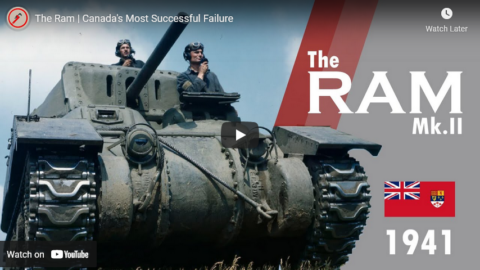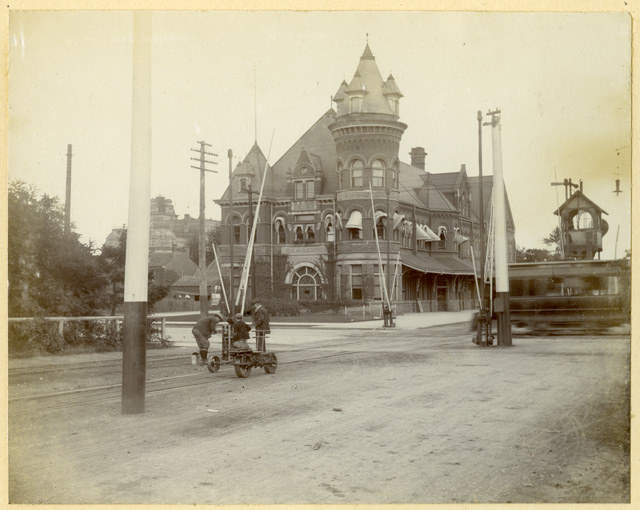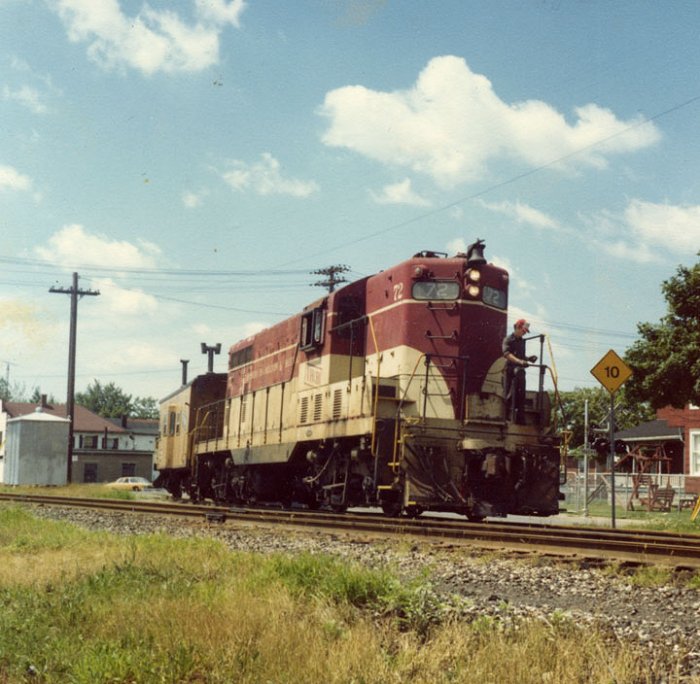The Raven’s Eye
Published 8 Nov 2022It was called “The Mississauga Miracle” — a train derailment involving 26 cars of toxic and flammable materials, just a few miles from a major Canadian city center. Faced with the prospect of a cloud of killer phosgene gas being released, authorities had no choice but to order the mass evacuation of an entire city …
(more…)
November 11, 2023
The Mississauga Train Derailment (1979)
QotD: Diary entry, 11 November, 1979
I hope you’ll forgive my self-insert here, but watching the video on the Mississauga train derailment prompted me to dig up a bit of personal history related to this thankfully non-tragic event in Canadian history. This is what I wrote about the events of that week not at the time (I was far too busy living it to record anything) but a couple of months after the fact. Samuel Pepys I wasn’t. I note in passing that my memories today don’t exactly match what I wrote in early 1980, which does bring home to me the fallibility of “eyewitness” reports after the fact.
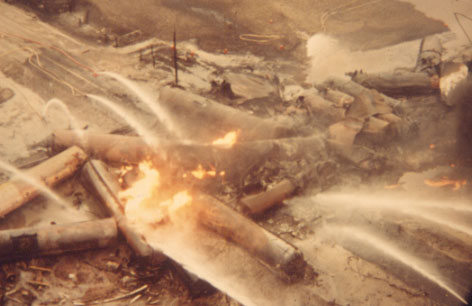
On the night of November 10, 1979, a 106-car Canadian Pacific freight train derailed at Mavis Road, north of Dundas Street. As a result of the subsequent explosion, when one of the tank cars carrying propane exploded, and because other tank cars were carrying chlorine, the decision was made to evacuate nearby residents in one of the largest peace time evacuations in history. This photo shows flames from the wreckage, with hoses pouring water on it.
Photo from the Mississauga Library System website, Identifier M466. Full gallery here.
In November of ’79, on the 11th actually, a chemical train derailed just northwest of [our apartment near Dundas and Hurontario Streets]. It spilled 16 tank cars full of propane and one full of chlorine all over the Mavis Road crossing.
I was driving back to Hamilton on Saturday night to drop off [my girlfriend]. Rockney was inexplicably along with us that night. Around midnight, I noticed the road all around us light up as though dawn had come early. Also noticed a pronounced mushroom-type cloud and lots of incident light at its base. Right there, my mind kicked into Hyperdrive and I analyzed the data, assumed the worst, and nearly swung off the highway to protect us behind an embankment. [The others] saw that it wasn’t an H- or A-type of explosion, and so we didn’t worry too much. Flames [on the eastern horizon] were easily visible from Hamilton.
I went back [to Mississauga], dropped Rockney off [and] noticed a police car blocking the intersection of Dundas and Hurontario with its lights going. Talked to Mum, who was still up, and went to bed at 3:00am.
We were woken up at 10:00am by police evacuating the building. I called Rockney and we all trooped over to his place. I stayed for 1/2 an hour, and decided to go back to the house, change into [my army reserve] uniform, and go up to Brampton for our Remembrance Day parade. On the way, I was stopped by the police and directed to go to Square One, where an evacuation centre had been set up. As I arrived there, the last bus-load of evacuees left headed for Streetsville Secondary School. I arrived there in time [to be given responsibility for security] with 15 assorted army and navy cadets [who were in uniform for their respective Remembrance Day services] who had no officer handy. We cleared the halls [at the direction of police and school authorities] and tried to maintain calm among the evacuated throng.
By 8 that evening, my force had shrunk to seven cadets led by Petty Officer Linda P. An officer cadet of the Air Reserve and five air cadets with him refused to assist me or the police. [I was angry at the time, but he was probably worried about the legal side of providing “aid to the civil power” while in uniform without permission from his chain of command. I was a junior NCO, so that thought never crossed my mind until much later.]
By this time, I had attached Chris P. [a friend of Rockney’s who was evacuated to Streetsville] and several other husky teenagers to my “security force” and we were able to keep things fairly quiet.
As people [started to realize] that they would be there all night, most of them settled down very nicely. [My team of cadets] issued blankets we’d received on a truck from CFB Downsview and shared out the available gym mats [as makeshift mattresses].
A local McDonalds sent in a “breakfast” of cold Big Macs [I’m sure they were hot going out the door, but they took a long time to get to us] — [the non-cadet members of] my security force got more than their fair share, but that was expected. Most of the media had disappeared by this time so we soon got involved in minor disputes with some irate citizens.
Sometime during Monday afternoon a Master Corporal from CFB Downsview called me to arrange a coffee run down to the [emergency crews working to contain] the fire. Nothing came of it in the end [I have no idea why they thought I’d be a useful participant, as I had no transportation other than my own car … maybe I was the only member of the military in the immediate vicinity].
Tried calling Rockney’s place [to see how my family were doing] but got no answer, same at Bill & Clive’s apartment [several miles further east of Rockney’s]. No idea where my parents have gone. [After being evacuated a second time, they’d ended up at the International Centre with the family cat and stayed there until later in the week, as I found out later. My sister hadn’t been at home so she was evacuated elsewhere with her boyfriend’s family. I have no idea where she spent the week.]
Monday night wasn’t too bad, except for [media reports] that there were 3 escaped cons in the area so i couldn’t send girls out alone on security sweeps [outside the school building]. Me, Chris P., Jordan L., and John D. were the only [ones available to do exterior security] now, getting VERY tired. Got an hour’s sleep.
On Tuesday a bunch of students from Humber College showed up. They were all taking the Law Enforcement course and wanted to help me with security. [The] only problem was that the course was 9/10ths female [so] I couldn’t use them [for exterior patrols, which is where we needed help the most].
Also showing up [later on Tuesday] was a local CB radio group who tried to take over from me and my team. It took two hours [of argument] before they gave up and went off to try to take over some other evacuation centre. [Around this time,] vandalism started on the back side of the school and in the portable classrooms. No one was caught at it, unfortunately. [I didn’t note it here, but I strongly suspected that one or more of my volunteers had done some of the damage out of boredom, but I had no proof.]
The biggest problem, however, was racial. A large group of black teenagers had taken over one of the Home Economics classrooms and had 2 competing ghetto blasters to make mucho noise. 2 fights had to be broken up in there and we had to call the police in to cope with the second fight.
[Tuesday] night was uneventful for a change. Wednesday wasn’t, as rumours of being able to go home kept hitting the people in the evacuation centre and nearly overwhelming the security teams at the doors. One asshole, a guy about 20-25 years old, kept buttonholing me and other members of my team and demanding shampoo, of all things. Eventually, someone got him some and he “went to the showers”. [In hindsight, he probably had just come down from whatever drugs he’d been on for the previous few days.]
On Wednesday night, the evacuation centre in Streetsville was shut down and everyone was moved to other facilities on Mississauga Transit buses. Most were taken to the Royal York Hotel in downtown Toronto, but my remaining team members were sent to a Holiday Inn in Scarborough. [I was in rough shape by then and someone got me to hospital to get checked out. I was there for about 10 hours before they discharged me with advice to “get plenty of rest”.]
Thursday we spent in the hotel, charging everything to CP Rail. They must have hit the roof when the bill arrived — especially the bar bill! We threw an “exhaustion party” in our room on Thursday night and on Friday we were finally allowed to go home (most of us, anyway).
When I went back to school the following week, I was given the third degree by the vice principal because the Red Cross didn’t have me listed as an evacuee. I had to get the hospital records to show that I had actually taken part before I was allowed back into class. [A similar thing happened the next unit parade night, as I’d been on TV several times in my uniform during the event and my commanding officer was quite upset about it, thinking I’d been pretending to act in some sort of official capacity, which I hadn’t been.]
November 19, 2022
QotD: Canada from the American Revolution to the Riel Rebellion
A significant number of Americans who were loyal to Britain and despised the American Revolution moved to Canada during and in the decades after the Revolutionary War. And as the number of English Canadians steadily increased along the Great Lakes and west of the Ottawa River, [Sir Guy] Carleton created what became the province of Ontario, Upper Canada, in 1791. The first lieutenant governor, John Graves Simcoe, devised and implemented an ambitious program of enticing Americans to Canada by effectively giving them rich farmland. The population of English Canada rose swiftly toward parity with the French. In 1792, Simcoe took it upon himself to abolish slavery in Upper Canada, 42 years before this was done in the British Empire, and 71 years before the United States. It was an admirable and pioneering endeavour in the principal area of civil rights controversy in North America in the coming century.
Unfortunately, as the Revolutionary and Napoleonic wars unfolded, the British could not resist the temptation to employ their mastery of the high seas to impose blockades and harass the shipping of neutral powers. The young United States did not have the military force to deter such treatment, and in 1812 those countries went to war. Canada was the blameless focal point of most of the fighting. Canada with the continuing solidarity of the French-Canadians, was able to mount a very solid defense. The many thousands of recently arrived Americans did not support the United States and the generous policy of enticing settlement from the United States was completely vindicated. There were pressures to expel them, monitor them, disqualify them from holding local offices and positions. But it was soon agreed that they could become citizens after eight years of residency. This affected about 40 percent of English-Canadians and this must count as another very successful chapter in Canada’s early record of respect for civil and human rights.
As reasonably successful wars do, considerable national sentiment was created and encouraged by the successful joint struggle to avoid American occupation. Out of these experiences came increased ambitions for democratic self-rule in domestic matters as the British and Americans enjoyed, instead of autocratic rule by British governors. Canada’s position was complicated by the fact that it could not agitate for home rule too energetically or the British would lose patience and sell Canada to the United States for cash or other territory or for a comprehensive alliance. Outright rebellion was not an option for Canada as it had been for the Americans, as the United States would seize Canada if it were not under British protection.
The Canadian solution for agitating but not completely exasperating Great Britain was the Gilbert and Sullivan rebellions of 1837 led by William Lyon Mackenzie in Ontario and Louis-Joseph Papineau in Québec. The Ontario uprising was just a rowdy group of malcontents who became disorderly and were easily chased off, and the French-Canadian group were essentially pamphleteers, though there were some exchanges of fire and small rebel and military units marched to and fro in poor winter weather. A total of about 300 people died, there were 14 executions and 92 people were transported as prisoners to Australia. The rebel leaders fled but were eventually pardoned and returned.
There was enough commotion to get Britain’s attention, but the loyalty of most of the population gratified the British, and they determined to put things right. London sent the well-known reformer Lord Durham to Canada in 1840 to make recommendations. After a year of research by a couple of biased examiners, Durham came to the insane conclusion that the source of Canadian discontent was that the French-Canadians wanted to be relieved of the intolerable burden of being French. Durham proposed uniting Upper and Lower Canada and assumed that the slight resulting English majority would assimilate the French in about 10 years. Of course, this was precisely what the French feared, and the English-Canadians had no desire for it either. But after several years of rearguard action by British governors, the movement for autonomous government succeeded, after the 25-year-old Queen Victoria sent Lord Elgin to Canada as governor to give the Canadians what they wanted. Elgin and Robert Baldwin and Louis-Hippolyte LaFontaine achieved this and secularized a great deal of territory owned by the principal churches so that they could be more easily settled and made the principal universities officially nondenominational. These were again great and non-violent steps in the civil rights of Canadians who now numbered over two million people.
All of North America was now walking on eggshells over the immense problem of American slavery. Slavery was abolished throughout the British Empire in 1834. In practice, there had not ever been more than a couple of hundred slaves in Canada, apart from the natives enslaving each other. Slaves had been imported to the southern states because of their efficiency at harvesting tropical crops such as cotton, so Canada was effectively spared that horrible institution, because of its climate more than its virtue. Canada consistently had a fine record in accepting about 40,000 fugitive slaves that reached the Canadian border in the thirty years before the U.S. Civil War. The leading American anti-slavery advocates Harriet Tubman and John Brown, and Josiah Henson, the model for the chief character in Harriet Beecher Stowe’s novel Uncle Tom’s Cabin, which sold an unheard-of two million copies in the 1850s, all lived in Canada for years. There were at least 11 black Canadian doctors who were fugitive slaves or sons of fugitive slaves who served in the Union Army in the Civil War, and the white Canadian anti-slavery activist, Dr. Alexander Ross, at the request of President Lincoln, assisted in breaking up a Confederate spy ring in Montréal. Escaped slave Joseph Taper, of St. Catharine’s, wrote this letter back to his former and still putative owner in 1839: “I now take this opportunity to inform you that I’m in a land of liberty, in good health … In the Queen’s dominions, man is as God intended he should be; all are born free and equal, not like the southern laws, which put man on a level with brutes. All the coloured population is supplied with schools. My boy Edward, who will be six years next January, is now reading and I intend keeping him at school until he becomes a good scholar. My wife and self are sitting by a good comfortable fire, happy, knowing that there are none to molest us or make us afraid. God save Queen Victoria.”
As many as 40,000 Canadian volunteers served in the Union Army in the Civil War and Canada was thanked on several occasions by President Lincoln for infiltrating Confederate exile organizations. This was an issue in which all Canadians were united and is a legitimate matter of national pride.
The next major civil rights challenge that Canada had to face was that of the Métis — the mixed white and indigenous people on the Great Plains of Canada. The territory of the natives had been steadily reduced by white settlement and the nutritious content of their diet had been reduced by the heavy depletion of the herds of plains Buffalo. There were also many other grievances and undoubtedly a number of violations of the Indian treaties and of the Indian Act and a flamboyant Metis lawyer, Louis Riel, led an uprising on the western plains in 1878. This was eventually suppressed with little violence, as Prime Minister John A. Macdonald dispatched an adequate military force under Field Marshal Garnet Wolseley, Gilbert and Sullivan’s “very model of the modern major general”. Riel fled to the U.S. and the Canadian government made a number of useful concessions to the aggrieved natives. But in 1885, Riel returned and led a rebellion in northwest Saskatchewan. At the same time, the Canadian Pacific Railway ran out of money and was about to flounder into bankruptcy. Macdonald brilliantly sent Canadian forces West on the railway and they surprised and defeated the insurgents and captured Riel. By emphasizing the railway’s role in saving the country (as Riel was making both annexationist and secessionist noises), Macdonald won passage of a bill to finance completion of the railway. Macdonald also gave the natives the right to vote and rewarded his allies among the native leaders. However, he created a lasting grievance by allowing the execution of Riel. Although 15 people died in the uprising, he should have commuted the sentence for insanity — Louis Riel was delusional.
Conrad Black, “Canada’s excellent history of civil and human rights”, New English Review, 2022-08-18.
January 31, 2022
The Ram | Canada’s Most Successful Failure
Red Wrench Films
Published 4 Dec 2020A Canadian Franken-tank that pre-dated the M4 Sherman, the Ram would be an icon of Canada’s industry in the early war years. Ultimately a failure as a battle tank, variants of the vehicle would see combat in Normandy and beyond, as the Kangaroo APC which revolutionised mechanised warfare in 1944 and 1945.
Any feedback is greatly appreciated, I’m always trying to improve.
Any suggestions for the next video? Leave it down in the comments or message me. 🙂
((Like and subscribe))
Please note that the footage I can find on these vehicles is scarce and sometimes the video will not match properly or will perhaps be slightly inaccurate.
Sources:
https://tanks-encyclopedia.com/ww2/ca…
https://www.dday-overlord.com/en/mate…
https://www.friends-amis.org/index.ph…
http://panzerserra.blogspot.com/2015/…Intuit256 by Kevin MacLeod is licensed under a Creative Commons Attribution 4.0 licence. https://creativecommons.org/licenses/…
Source: http://incompetech.com/music/royalty-…
Artist: http://incompetech.com/
July 2, 2020
Fallen flag — the Toronto, Hamilton & Buffalo Railway
 This month’s Classic Trains featured fallen flag is my favourite Canadian railway … I founded the TH&B Railway Historical Society many years ago (you can download a PDF of the first newsletter I did here … I didn’t have access to any TH&B photo I could use in the publication at that point, so it’s pretty much all text and tables). I put together as much information as I had about the railway at that time and printed up a few hundred copies to distribute at a regional railfan event (the CN Lines event in Oakville during October 1997), hoping to find fellow fans of the TH&B (back in those long-distant days when you couldn’t just run a quick search from your web browser, and most people didn’t yet have email addresses). The gamble worked and we had a formal historical society up and running for the following issue. I published the newsletter for five years before finally burning out and handing it over to more capable hands.
This month’s Classic Trains featured fallen flag is my favourite Canadian railway … I founded the TH&B Railway Historical Society many years ago (you can download a PDF of the first newsletter I did here … I didn’t have access to any TH&B photo I could use in the publication at that point, so it’s pretty much all text and tables). I put together as much information as I had about the railway at that time and printed up a few hundred copies to distribute at a regional railfan event (the CN Lines event in Oakville during October 1997), hoping to find fellow fans of the TH&B (back in those long-distant days when you couldn’t just run a quick search from your web browser, and most people didn’t yet have email addresses). The gamble worked and we had a formal historical society up and running for the following issue. I published the newsletter for five years before finally burning out and handing it over to more capable hands.
The society is still in operation, and the newsletter (now called The Ontarian) is mailed out four times per year. Membership information available at the society website.
Greg McDonnell begins the article with a quick look at the TH&B’s early history:
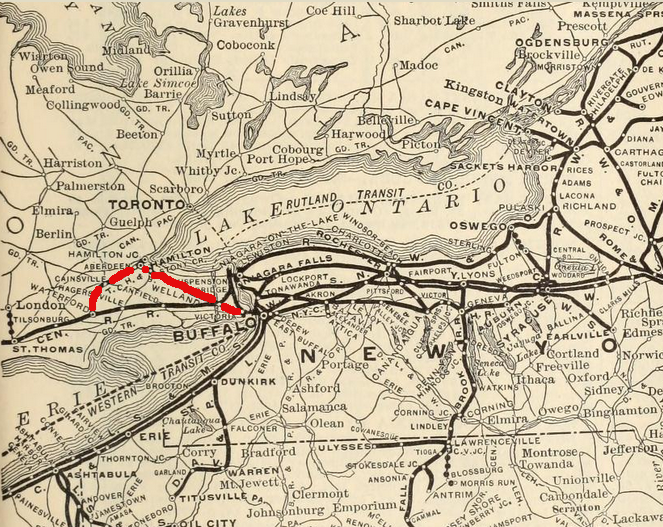
Detail from a map published in The Commercial and Financial Chronicle in 1908. TH&B trackage has been marked in red (not on the original image).
Wikimedia Commons.
Canada, thanks to its two transcontinental giants after 1923, had few small “regional” railroads. One, though, was the 111-mile Toronto, Hamilton & Buffalo Railway, which vanished in 1987.
Little TH&B had a larger-than-life presence that belied the reality of its being merely the southern Ontario stepchild that linked parents New York Central and Canadian Pacific. TH&B never realized its dream of being an independent road linking its three namesake cities, but in its heyday, it did haul sleeping cars from Toronto for New York, Boston, Cleveland, Pittsburgh, and Philadelphia. In 1911, it became the first North American railroad to install Absolute Permissive Block signaling; it erected a splendid art deco station and office tower in Hamilton, Ontario; and it had Canada’s only 2-8-4 steam locomotives, not to mention two ex-NYC Hudsons.
In 1890, even before a rail was laid, TH&B deviated from its chartered intentions, dropping Buffalo from its plans in favor of an eastern terminus and connection with the Canada Southern, a subsidiary of NYC’s Michigan Central, at Welland, Ontario. In 1892, TH&B acquired its first operating trackage, the faltering 18-mile Brantford, Waterloo & Lake Erie, a Brantford–Waterford line that was extending itself to Hamilton.
The original Hunter Street station in Hamilton, replaced in 1929 with the current Art Deco station now operated by GO Transit.
Local History & Archives, Hamilton Public Library via Wikimedia Commons.As crews spiked TH&B rails from Hamilton to Welland, the line’s strategic importance attracted suitors. And not just anyone, for on July 9, 1895, the still-incomplete railway was sold to a consortium headed by two of the most powerful men in North American railroading: NYC’s Cornelius Vanderbilt and CPR’s William Van Horne.
NYC, dividing its holdings with subsidiaries MC and CASO, took a 73% stake in the fledgling bridge line; CP held the remaining 27%, an arrangement that would endure for 80-plus years. TH&B was afforded a considerable measure of autonomy, but parental influence from New York and Montreal gave TH&B its unique international character.
The TH&B Society picks up the history in somewhat more detail (the original draft was mine, but several others have made additions and changes since then):
The next phase of construction was to be the line from Hamilton to Toronto. The surveyed route to Toronto closely paralleled the existing Grand Trunk Railway mainline. In order to avoid construction of a parallel line (and the potential loss of traffic to the competing line), the GTR granted running rights to the Canadian Pacific Railway between Toronto and Hamilton in 1896. That same year the TH&B constructed what became known as the Hamilton Connection between its line and the GTR at Hamilton Junction. The Hamilton Connection was subsequently leased to the CPR and became their physical connection to the TH&B.
In 1897, the TH&B obtained running rights over the Hamilton & Dundas Railway for the provision of freight service into the Town of Dundas. The H&D Railway, a local interurban line, ceased operations in 1923 and the TH&B acquired the former H&D right of way into Dundas to continue freight operations. The line into Dundas was known as the H&D Branch.
In order to tap into Hamilton’s expanding industrial sector, construction began on the Hamilton Belt Line in 1900. The Belt Line expanded with the construction of two additional branch lines in 1911 to allow access to all industrial sectors of the city, many of which were previously serviced exclusively by the GTR. Although the Belt Line was only six miles in length, it contained over 40 miles of yard and industrial sidings and would provide much financial sustenance to the TH&B over the years.
In 1914, the 14-mile Dunnville Subdivision was constructed southward from Smithville to the Town of Dunnville and extended five miles further to the shores of Lake Erie at Port Maitland in 1916. Access to Lake Erie allowed the creation of the TH&B Navigation Co. that operated between Port Maitland and Ashtabula, Ohio, from 1916 until discontinuance in 1932.
The TH&B’s final expansion occurred in 1927 when running rights were awarded over the Canadian National Railways to gain access to the industrial City of Port Colborne.
1935 saw the first abandonment of trackage when the Ridgeville Spur, a small four-mile branch extending off the Welland Subdivision just outside of Welland, was abandoned and the rails were removed in 1936.
The St. Lawrence Seaway Authority completed the construction of the present-day Welland Canal in 1972 resulting in the relocation of several rail lines in the area. The Welland Subdivision was realigned between Fenwick and Welland where a new yard was constructed and operated in conjunction with New York Central’s corporate successor, Penn Central. The new shared facility allowed the closure and removal of the original and independent TH&B and Penn Central operations located within the city. Welland Yard continues to operate today as a Canadian Pacific’s marshalling facility for the Niagara Region.
In 1976, the United States Government amalgamated six bankrupt railroads, including the New York Central’s corporate successor, Penn Central, into a new entity called Conrail. In an effort to reduce debt, Conrail began shedding foreign investments including their controlling interest in the TH&B. In 1977, CP Rail acquired Conrail’s 73% interest giving CP 100% control of the railway.
In 1985, CP Rail and Canadian National jointly acquired the assets of Conrail’s Canada Division, the former Canada Southern Railway. CP Rail acquired exclusive ownership of the eastern end of the line between the TH&B connection at Welland and the international border crossings at Niagara Falls and Fort Erie, Ontario. While CP equipment was used to operate this portion of the line, known as CP CASO, the TH&B provided the managerial and administrative functions on CP Rail’s behalf.
The TH&B would continue to operate as a separate entity until 1987 when it was amalgamated into the Eastern Region of the London Division of CP Rail.
CP Rail abandoned the H&D Branch in 1988 with the Waterford Subdivision following in 1989. Also in that year, CP discontinued operations into Port Colborne, opting not to renew the running rights agreement over the CNR.
Today, the surviving portions of the TH&B, including the Hamilton Belt Line, the former Welland Subdivision and a portion of the Dunnville Subdivision operate as part of Canadian Pacific’s Hamilton Subdivision in CPR’s Southern Ontario Service Area.
May 20, 2017
On board The Canadian
The Toronto Star‘s Jennifer Bain takes a trip on VIA Rail’s premier passenger train from Toronto to Vancouver:
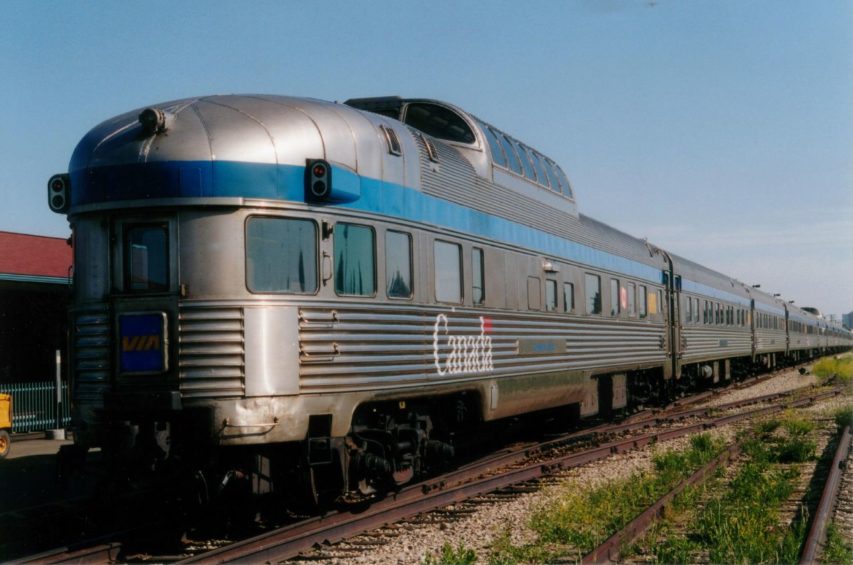
VIA dome observation car, 2007. Photo by Savannah Grandfather (Wikimedia)
ABOARD THE CANADIAN-That first overnight on the train was a gloriously sleepless blur disrupted by clickety clacks, rumbles, grinding squeals and ding, ding dings. Alone in F-130 in the Château Cadillac car on a Murphy bed pulled down from the wall to fill the room, I stared mesmerized through an extra-large window into the dark depths of northern Ontario and thought deeply Canadian thoughts.
Happy 150th birthday, Canada. This year cries out for a celebratory road trip. I use the term road loosely. A train track will do just fine. Let someone else drive. For four nights on the Canadian, Via Rail Canada’s iconic train from Toronto to Vancouver, I relaxed and watched boreal forest become prairie and then mountains.
Somewhere north of Sudbury that first morning, I threw on clothes and tiptoed down the narrow hall, hands outstretched to brace for sways and lurches, through the Château Dollard sleeping car to the end of the train.
The Laurentide Park car is tricked out with a downstairs lounge and upstairs domed seating area. The DIY tea and coffee station became my watering hole.
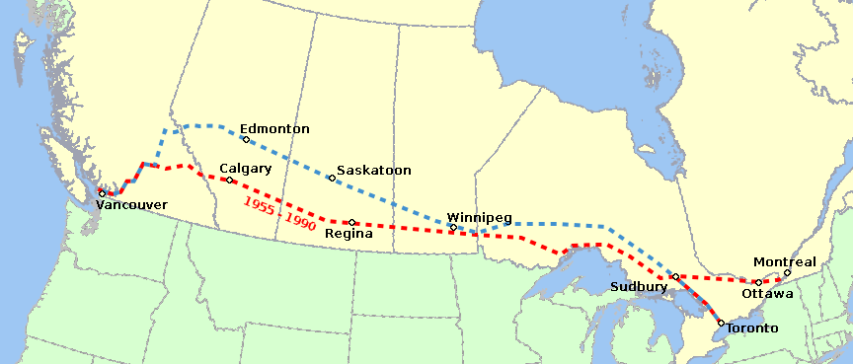
Routes of The Canadian: the original 1955 route is in red (on CPR trackage) and the current route is in blue (mainly on CN tracks). VIA took over operation of The Canadian in 1978 and changed to the current route in 1990.
You are in your own world on the Canadian, but not necessarily alone. Work on the lost art of small talk in the dining car when you’re seated with strangers. Play a board game with fellow passengers since there’s no Wi-Fi and often no cell service.
This 4,466-kilometre journey is a throwback to simpler times.
Jason Shron — a train nut from Thornhill that I met through Box — has done the Canadian upwards of 40 times and found “there’s a tendency for people on the train to spill their guts to strangers,” especially if they’re on divorce tours, which can become awkward the next day. “There’s a certain magic to that,” he admitted. He was taking his three kids to Winnipeg to meet his wife and other family for Passover.
Shron owns Canada’s largest model train company, built a section of a full-size Via car in his basement, is restoring two train cars and is writing a book about Via for its 40th anniversary next year. The Crown corporation “doesn’t celebrate its own history and doesn’t celebrate its own people” nearly enough, he lamented, and so he’s “like this one-man Via fan club.”
Make that two. Shron and Box love trains for different reasons — the actual machines and the art of train travel — but they are anomalies. Too many Canadians have never been on a train, much less slept on one.
Trains are not a part of our modern lives or lexicon, so my learning curve is steep. Passenger trains don’t have cabooses, conductors are obsolete and drivers are called engineers. Freight trains have priority in Canada when there’s one line, so passenger trains like the Canadian have to wait on the siding, causing delays.
There are economy-class seats that you sleep upright in, and banks of seats that convert into upper and lower “berths” at night with just a curtain for privacy. There are private rooms, some with a toilet that gets covered when the bed comes out, and a shared shower down the hall. I was lucky enough to experience “Prestige class” in a room with an L-shaped couch, Murphy bed and private en-suite washroom, with access to a trio of concierges, reserved seating at the front of the dome car, meals, booze and all the Earl Grey I could drink.
Part of the reason “many Canadians have never been on a train” is that there are a lot fewer trains running today than in years past: when VIA took over most intercity passenger service, it rationalized a lot of the routes (but not enough to become profitable, hence the federal government’s ongoing subsidies to VIA). Even with those subsidies, passenger trains aren’t a bargain for the average traveller, and usually compare poorly to bus or air travel in both cost and frequency. Most of VIA’s trains lose money, as this table from 2014 shows:
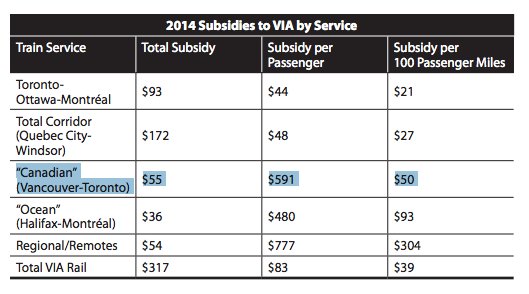
So, how expensive is the trip that Ms. Bain took? I went to the VIA website to find out. Booking a trip from Toronto (in my case, Oshawa) to Vancouver on The Canadian to leave today (Saturday) would cost an eye-watering $9,684.10 per person in Prestige class (including a $500 service fee, but not including HST [Harmonized Sales Tax] of $1,114.10). There are cheaper fares — booking in advance, not taking the Prestige class ticket, other available sales, etc. — but a quick Google search shows return flights in the $600 range (but I could save $226 off that if I booked for tomorrow instead of today).
For a potted history of The Canadian there’s a useful Wikipedia page.
May 1, 2017
The Canadian Pacific Railway – 1920s Across Canada by Train, All ABOARD!
Published on 6 Apr 2017
Historical footage of the places and highlights of one of the greatest train journeys in the world, a trip across Canada from sea to sea on the Trans-Canada Limited, Canada’s fastest transcontinental train.
The Trans-Canada Limited was considered as one of the world’s finest trains in its time. The concept of this train was that of a de luxe ‘Hotel-on-Wheels.’ It was the world’s longest-distance all-first-class sleeper train, with the fastest time across the North American continent from one ocean to the other.
The Trans-Canada Limited was operated by the Canadian Pacific Railway. It was inaugurated in 1919, just after World War I, and lasted until 1930.
As a result of the economic depression following the great Stock Market Crash of October 1929, it was cancelled in 1931. As with any other CPR passenger train, the equipment was the very best available, yet in June of 1929 the whole train was completely re-outfitted with 10 brand new sets of cars – each set costing in excess of one million dollars.
This early travelogue documents travel across Canada by rail, introducing major cities and places of interest. Traveling over 3,600 miles from the Atlantic Ocean to the Pacific takes five days to by the Canadian Pacific Railway.
The journey starts in Saint John, New Brunswick on the Bay of Fundy. Highlights of the trip are: Algonquin Hotel; salmon fishing. Quebec City is the oldest city in the North America; The Chateau Frontenac Hotel towering over the St Lawrence.
Montreal is Canadian Pacific headquarters and Trans-Canada Limited. Ottawa is the capital of the nation. Toronto is the Queen City. Niagara Falls is connected to the French River and Georgian Bay. [edit: no, unless you include the Niagara River, Lake Erie, the Detroit River, Lake St. Clair, the St. Clair River, and Lake Huron] Canadian Pacific steamer carries its passengers across the Great Lakes.
Winnipeg to the prairies and across the prairies through Regina and Saskatoon. Arrival at Calgary and Edmonton. Banff and Lake Louise are located in the Canadian Rockies. Through the Rockies, the train ends in Vancouver where English Bay and Stanley Park are located. The city of Victoria gives an image of England on the Pacific.
Source footage: The National Archives of Canada – https://www.canada.ca/en/library-archives.html
February 4, 2015
CP Rail offering engineer training to office staff
Laura Spring linked to this interesting bit of news that CP Rail is “encouraging” non-unionized employees to take training on how to operate locomotives:
A Canadian railway company is training its managers and office workers to drive locomotives and load trains, a move one labour lawyer says could be an attempt to prepare for a possible work stoppage.
Documents show CP Rail has encouraged office employees to step away from their desks and cubicles and sign up for training both on the trains and in the rail yards.
The use of office workers driving trains could be a major safety concern, said Wayne Benedict, a former railroader who now works as a labour lawyer in Calgary.
“You’ve got them climbing onto a train that’s a mile and a half long, with a hundred and some cars, weighing 16,000 tonnes, with dangerous goods, going through our cities,” he said. “And they are not professional, running trades employees. They are running human resource professionals, or other managers and supervisors.”
CBC News has obtained an internal CP Rail document dated Feb. 19, 2014, encouraging non-union employees to sign up for training as a locomotive engineer or conductor. It calls the training “a requirement at Canadian Pacific. It is also the single best way for a management employee to learn what the business is truly about. It is a fundamental cornerstone to the development of our railway culture.”
The document also suggests, “no matter what your role is at CP, this experience will make you better at what you do.”
The program is targeted mainly towards mechanical and engineering workers, but open to any non-union employees.
December 25, 2014
July 1, 2012
“Canada was born in debt”
At the Worthwhile Canadian Initiative blog, Livio Di Matteo explains one of the less mentioned but urgent reasons behind confederation in 1867:
The trials and tribulations of the European Union, its debt crisis and the Euro and the suggestion that part of the solution lies in a stronger fiscal union reminds me of the forces behind the drive for Canadian confederation in the mid-nineteenth century. Canadians are usually taught in school that major forces driving Confederation were the potential threat of territorial aggrandizement by the United States in the wake of the Civil War or the need for a larger market given Britain’s move to free trade and the end of Reciprocity with the Americans or the desire to generate the economic resources to build a railway to the west so that it could serve as an investment frontier.
One factor that receives very little mention is the fact that the prior to 1867 the colonies of British North America were heavily in debt and faced a fiscal crisis of their own. The solution to the colonial debt crisis that Confederation allowed was the creation of the federal government that was given strong revenue raising powers and assumed provincial debts and thereby stabilized the public credit. Public debt charges in 1867 already accounted for 29 percent of federal budgetary expenditure and by 1880 had only been whittled down to about 24 percent. Canada was born in debt.
Canada was created with a large debt as the provincial and local levels of government had invested heavily in transportation infrastructure — canals and railways in particular. In 1850, there were only about 66 miles of track in operation but by 1860 about 2000 miles of track had been built in eastern Canada. The total cost of building these railways in British North America up to 1867 was 145.8 million dollars the bulk of which was for the Province of Canada — Ontario and Quebec. By way of comparison, Canada’s GDP in 1870 has been estimated at about 383 million dollars.
[. . .]
Confederation was designed to fix a massive debt problem. Creation of a new political entity — the dominion government — would allow for the current debt burden to be serviced and for more credit to be obtained on foreign markets to fund the railway projects of the late 19th century — the CPR, Canadian Northern, etc… Confederation was a solution to the debt crisis but required a form of government that reduced sovereignty for the member units in order to stabilize the public credit. In the Canadian case, as acrimonious as the discussions were, the process was facilitated by the fact that the member units were all British colonies with similar institutions.
February 26, 2011
The increasing length of freight trains in Canada
Some eye-opening statistics on the length of freight trains being run by Canadian National (CN) and Canadian Pacific (CP) these days:
Transport Canada launched a six-part study into the long-train strategies at the country’s largest railways this month with an eye on developing policies for how these longer, heavier trains are assembled and run. The goal of the two-year study is to develop science-based regulations that will hopefully reduce the number of derailments in the country.
Despite the concern from regulators, these longer, heavier trains in recent years have been a godsend for North American railways, which swear by their safety. Not only do they improve the efficiency of the rails by reducing the number of trains required to transport goods, but they in turn reduce the crews needed and the fuel used to move their shipments.
If properly built, they can also reduce wear and tear on the trains and the tracks themselves by cutting down on in-train forces, lowering maintenance costs substantially over time.
The cynic in my asks why, if CN (for example) actually managed to reduce the number of rail accidents to an all-time low last year, the regulators are now launching the investigation. Fewer accidents now equals a point of serious concern on the part of the regulators? Why?
Up until the 1990s, the average freight train in Canada was about 5,000 feet (1.54 kilometres) long and weighed 7,000 tons. But it is now not uncommon to see these trains stretch to 12,000 feet, sometimes as much as 14,000 feet (more than four kilometres), weighing up to 18,000 tons.
While CN is comfortable sticking with the size of its longest trains now, about 12,000 feet, CP continues to push the boundaries of how long it can build its trains by developing some of the industry’s most cutting-edge technology in recent years to help it do so.
The benefits are clear. CP estimates, for example, that the labour costs alone on a typical transcontinental train are now 30% lower than they would be if it was using smaller trains.
So, the trains are longer, carry far more freight, cost less to run, and customers are happy. The government must act!

